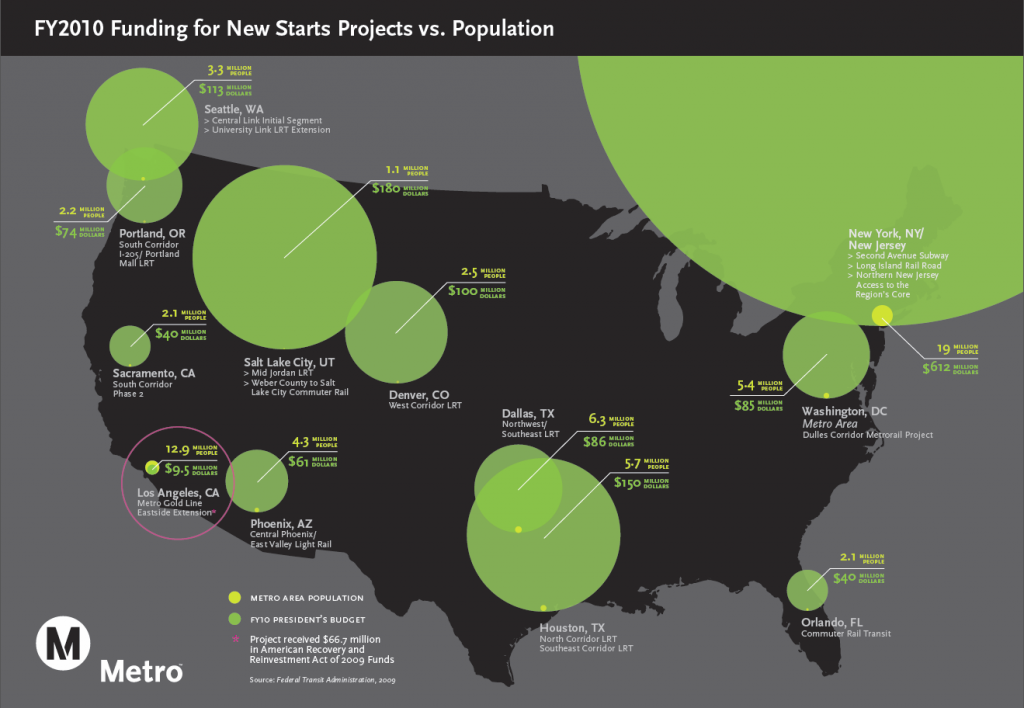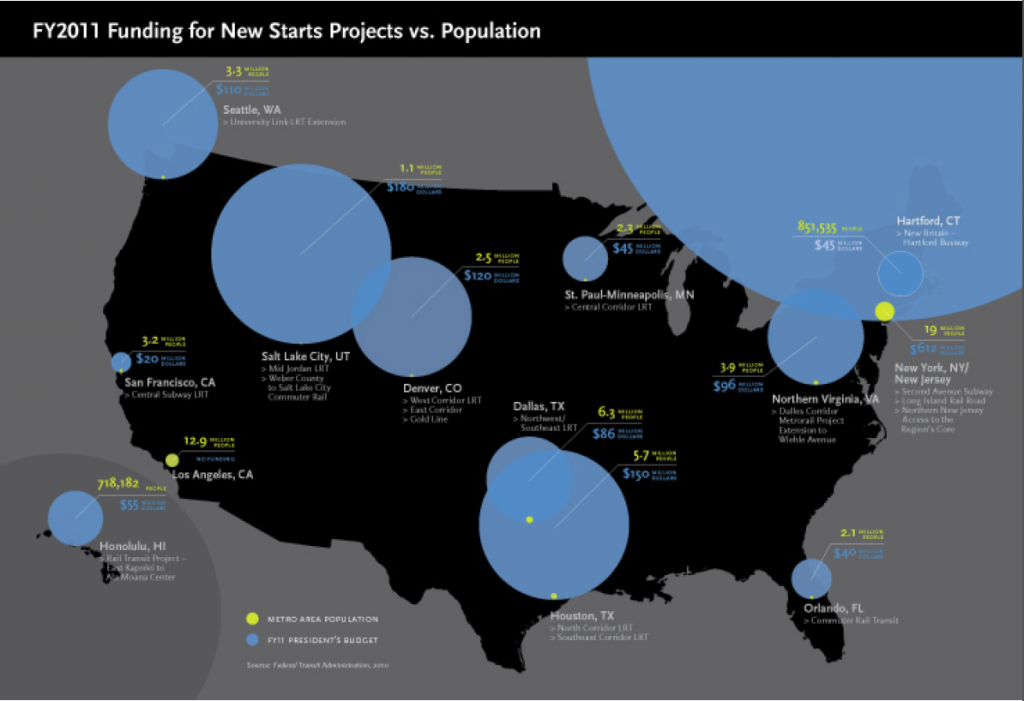Infighting could derail federal transport bucks for L.A.
by CalWatchdog Staff | June 14, 2012 7:10 am
June 14, 2012
By Tori Richards
Los Angeles stands to receive federal transportation dollars for the first time in nearly a decade, yet local infighting could derail the project, officials say.
Allegations of influence peddling with a campaign donor tied to President Obama and lawsuits charging corruption at the Metropolitan Transportation Authority have put the brakes on the final leg of a $5 billion subway project through L.A.’s Westside[1].
With a new freeway lane costing more than $1 billion, the project was seen as a godsend to an area that has some of the nation’s worst traffic congestion.
The disputed route runs underneath Beverly Hills High School, with a subway stop at Constellation and Avenue of the Stars in Century City. That’s where Obama donor JMB Realty owns a slice of land.
The city of Beverly Hills and its school district sued the MTA when a presentation of their scientific study showing the route to be hazardous fell on deaf ears.
“It needs to be ready to go on our end and these lawsuits complicate things,” said Dan Rosenfeld, senior deputy to L.A. County Supervisor Mark Ridley Thomas. “We could lose out on this funding if it drags through the courts. Not to mention the huge legal cost. Who pays for that? It’s not fair to stick it to the taxpayers.”
Added Michael Cano, transportation deputy for LA County Supervisor Michael Antonovich:
“Federal funding matching on the subway requires you to be aggressive on the timeline. You have to demonstrate a good financial plan and operating system. Problems associated with the lawsuit and delay and it loses out on a round of federal funding. The public as a whole loses out.”
A bill making its way through the U.S. Senate Appropriations Committee appropriates funds for seven transportation projects throughout the state. Sen. Dianne Feinstein, D-Calif., sits on the committee.
For nearly a decade, federal transportation dollars have been awarded to New York, Dallas, Denver and other cities, largely ignoring California and its pressing need for a better rail system.
“It’s shocking how little we get,” Rosenfeld said. “California is 10 percent of the U.S.and L.A. is 40 percent of California and we get peanuts in the federal transit cafeteria compared to other cities. We should get our fair share, but zero isn’t a fair share.”
 [2]
[2]
For example, New York — which already has the nation’s biggest subway system — has received $612 million for various rail projects. Other projects have included Dallas at $236 million, Salt Lake City at $180 million and Seattle at $113, according to MTA records.
“They are tunneling through rock on the east side of Manhattan, it’s not an easy project,” Rosenfeld said.
He added that their success in grabbing dollars could be because “they have very effective senators and one of them is now secretary of state.”
The last big money was in 2004, when Los Angeles received $66 million for its Goldline[3] subway.
David vs. Goliath
The project started out innocently enough: build an extension of the subway system to the Westside, where the only current transportation options are taking the bus or driving along the gridlocked 405 Freeway.
The project would continue on from the Wilshire Center area through Beverly Hills, Century City and Westwood.
The entire project was expected to take 30 years to complete at a cost of $5 billion and the MTA was counting on the federal government to pick up half the tab.
At first, the city of Beverly Hills was highly supportive of the project and Measure R[4], a 2008 ballot measure that raised the Los Angeles County sales tax half a cent to support transportation projects. That money would largely be used to fund rail projects.
And initially, the final leg of the subway was supposed to have a station near a golf course, with little impact on anyone. But then the site inexplicably changed to a busy street corner where the project developer JMB Realty owns the parcel of land, charged Brian Goldberg, president of the Beverly Hills Unified School District Board of Education.
The first route would have been faster and up to $100 million cheaper, so none of this made sense to Goldberg.
Tunneling 70 feet under the high school could expose thousands of students to myriad potential disasters, such as the escape of methane gas, former oil well sites and shifting ground, Goldberg said.
“We’ve confirmed with the Department of the State Architect that there’s been no tunneling under instructional buildings anywhere in the state of California,” Goldberg said. “We don’t know if the state architect would even approve construction.”
The school district wanted to give the state that opportunity, asking the MTA board to postpone its decision on the route until further studies could be done. But the board had hired a geologist who claimed that the first proposed station site was on an earthquake fault and the new route was approved.
A second geologist hired by the school district had come up with an opposite conclusion, saying the school has had underground erosion problems. Furthermore, if the first site was home to an active earthquake fault, the city of Los Angeless houldn’t have approved plans for construction of a 39-story office building there, the Beverly Hills geologist noted.
But the MTA board of directors is comprised of elected officials, including L.A.’s mayor and the members of the Board of Supervisors. Chicago-based JMB Realty’s executives[5] have donated at least $5,000 to Mayor Antonio Villaraigosa’s campaign coffers dating back to 2005, MapLight Research shows[6].
Media reports[7] show that JMB’s billionaire owner, Neil Bluhm, is a big Obama supporter[8] and even threw him a 49th birthday party. Public records reveal that he has donated hundreds of thousands of dollars[9] over the years to the Democratic Party and its candidates.
Villaraigosa has made no secret of his ties to the Obama administration and his quest to seek higher office.
“They are heavily connected to Obama and Rahm Emanuel,” Goldberg said. “Coincidences in politics and money are few and far between. These developers are smart people and the reason why they make a lot of money is they know how to work the system.”
Goldberg said JMB Realty’s and the MTA’s insistence on that piece of property for the station “doesn’t smell right.”
Anotonovich, whose district doesn’t include the rail project, has been the only direct supporter of Beverly Hills’ position. Ridley Thomas was not present the day of the vote.
“It’s very frustrating, the city just wanted a fair chance to represent their information to the MTA board,” Cano said. “[Antonovich] felt compelled to stick up for the city of Beverly Hills because they needed a voice on the board.”
In addition, Antonovich is troubled by the appearance of impropriety with the campaign contributions.
“That should’ve been explored, the relationship between the developer and MTA,” Cano added. “It’s definitely something you worry about. We have no first-hand knowledge [of impropriety], but it’s a legitimate question to ask to make sure the public feels a decision based by the MTA board is fact and science and not political considerations.”
The Result
Following a lengthy hearing, in which Antonovich was the only vote on their side, the city of Beverly Hills and the school district each filed lawsuits, asking a judge to reverse the board’s approval of the subway extension.
The city’s lawsuit accused the MTA of holding a sham hearing purporting to seek facts from Beverly Hills’ geologists, when in actuality a decision had already been made.
But the decision of a Superior Court judge won’t resolve the matter. The losing side will certainly file an appeal and the matter could be litigated for years. The MTA and its deep pockets could bury Beverly Hills in legal motions and paperwork. Although it’s a wealthy community, the city’s municipal assets pale in comparison to the billions MTA has at its disposal.
“Unfortunately, because we’re Beverly Hills, there is a stigma that it’s a rich, entitled community,” Goldberg said. “If it was any other route in the state, the response would be very different and more allies would be coming to our side.”
 [10]
[10]
- Westside: http://www.metro.net/projects/westside/
- [Image]: http://www.calwatchdog.com/2012/06/14/infighting-could-derail-federal-transport-bucks-for-l-a/richards-1-national-funding-for-transportation/
- Goldline: http://www.metro.net/projects/foothill-extension/
- Measure R: http://www.metro.net/projects/measurer/
- executives: http://maplight.org/los-angeles/contributions?s=1&politician=1076&election=2001%2C2002%2C2003%2C2005%2C2007%2C2009&string=Bluhm%2C%20Neil&type=cc%2Cie&business_sector=any&business_industry=any
- MapLight Research shows: http://maplight.org/los-angeles/contributions?s=1&politician=1076&string=JMB%20Realty&type=cc%2Cie&business_sector=any&business_industry=any
- Media reports: http://www.forbes.com/profile/neil-bluhm/
- Obama supporter: http://maplight.org/us-congress/contributions?s=1&office_party=Senate%2CHouse%2CDemocrat%2CRepublican%2CIndependent&string=Bluhm%2C%20Neil&business_sector=any&business_industry=any&source=All
- hundreds of thousands of dollars: http://query.nictusa.com/cgi-bin/qind/
- [Image]: http://www.calwatchdog.com/2012/06/14/infighting-could-derail-federal-transport-bucks-for-l-a/richards-2-new-starts/
Source URL: https://calwatchdog.com/2012/06/14/infighting-could-derail-federal-transport-bucks-for-l-a/